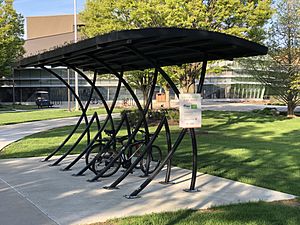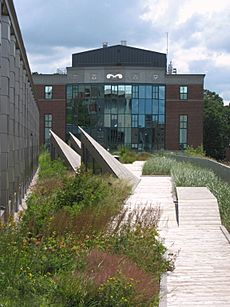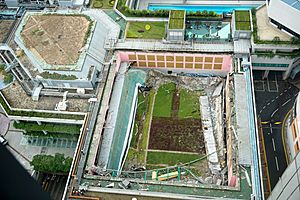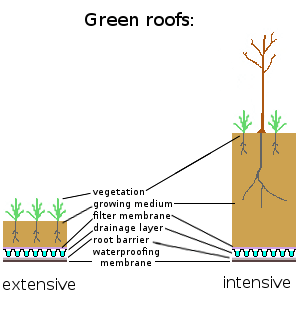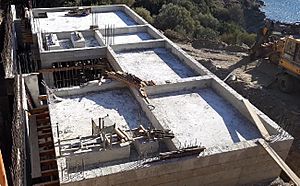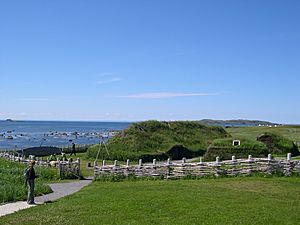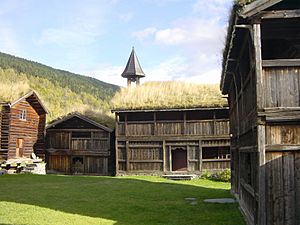Green roof facts for kids
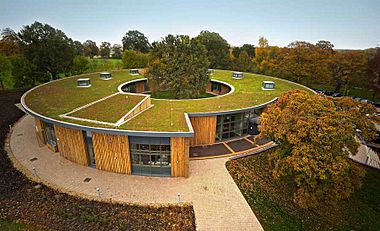
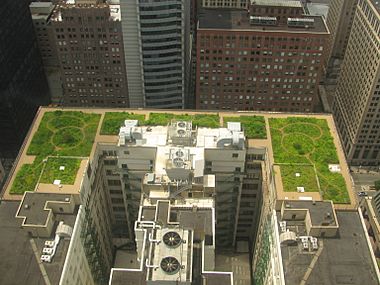
A green roof or living roof is a special kind of roof on a building. It is partly or fully covered with plants and soil. Underneath the plants, there's a special layer to stop water from leaking into the building. Green roofs might also have other layers. These include a barrier to stop roots and systems for drainage and irrigation (watering).
Green roofs do many helpful things for a building and the environment. They can soak up rainwater, help insulate the building, and create homes for wildlife. They also make places look nicer, which can help people feel less stressed. Green roofs help cool down cities, fighting something called the urban heat island effect. This effect makes cities much hotter than the countryside.
You can add green roofs to old buildings or new ones. They work well on small garages or large city buildings. They use plants to naturally clean water and air in cities and towns. There are two main types of green roofs:
- Intensive roofs: These are thicker, at least 12.8 cm (5+1⁄16 in) deep. They can grow many different kinds of plants, but they are heavier and need more care.
- Extensive roofs: These are shallow, from 2 to 12.7 cm (13⁄16 to 5 in) deep. They are lighter and need very little care.
Sometimes, the term green roof also means roofs that use other green technology. This could be a cool roof or roofs with solar thermal collectors or solar panels. Green roofs are also called eco-roofs or vegetated roofs.
Contents
Cool Benefits for Our Planet
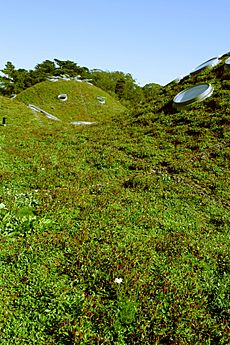
Saving Energy and Staying Cool
Green roofs help buildings use less energy. They can reduce the need for heating by adding insulation. They also help cool down cities by releasing water vapor, like plants do. A study in 2005 showed that green roofs can even reduce heat loss in winter. Another study found that if half the roofs in downtown Toronto were green, the city could cool down by 0.1 to 0.8 °C (0.2 to 1.4 °F).
Green roofs can lower how much a building needs to be cooled by 50 to 90 percent. This is because of "evaporative cooling," where water turns into vapor and takes heat with it.
When many green roofs are in a city, they can lower the city's average summer temperatures. This helps fight the urban heat island effect. Regular building materials soak up sunlight and release it as heat. This makes cities at least 4 °C (7.2 °F) hotter than nearby areas. But on Chicago's City Hall, which has a green roof, the roof is typically 1.4–4.4 °C (2.5–7.9 °F) cooler on a hot day. Many cities like Chicago and Portland encourage green roofs to help with this problem. Some cities even offer rewards to builders who add green roofs. It's thought that if all roofs in a major city were green, city temperatures could drop by as much as 7 °C (13 °F).
Managing Rainwater
Green roofs are great for managing stormwater runoff. This is rainwater that flows off roofs and streets. A study found that green roofs reduced water runoff by over 75% during rainstorms. The roof's soil stores the water, and plants take it up. Then, the water goes back into the air through evaporation.
Green roofs slow down and reduce the amount of runoff from a roof. They can hold up to 75% of rainwater. They slowly release it back into the air and keep pollutants in their soil. In some cities, heavy storms can overload the wastewater system. This can cause raw sewage to flow into local waterways. Green roofs help prevent this by holding back water.
Helping Nature and Wildlife
Green roofs create natural habitats in cities. Even on tall buildings, green roofs can attract helpful insects, birds, bees, and butterflies. They act like stepping stones for birds and other wildlife. This helps them find places to rest and feed when their natural homes are disappearing.
Green roofs also act like a green wall. They filter out pollutants and carbon dioxide from the air. This can help reduce diseases like asthma. They can also filter pollutants and heavy metals from rainwater.
Storing Carbon
Another benefit of green roofs is that they can store carbon. Carbon is a main part of plants, and plants naturally absorb it. The carbon is stored in the plant parts and the soil. One study found that green roofs stored a good amount of carbon in their plants and soil. We can improve this by choosing different plants, using deeper soil, or changing how we care for the roofs. Green roofs also indirectly reduce CO2 from power plants. They do this by insulating buildings, which means less energy is needed for heating and cooling. Buildings in the US cause 38% of all carbon dioxide emissions. Green roofs can help lower this number.
Other Cool Things Green Roofs Do
- They help insulate a building from sound. The soil blocks low sounds, and plants block higher sounds.
- Many green roofs can help buildings earn LEED points. LEED is a rating system for green buildings.
- They can create more space for growing food.
- Green roofs not only hold rainwater but also make its temperature more stable. They also act as natural filters for any water that does run off.
Costs and Money Benefits
Installing a green roof can cost more at first. An extensive green roof might cost about $108–$248/m2 ($10–$23/sq ft). An intensive green roof can cost $355–$2,368/m2 ($33–$220/sq ft). However, many parts of a green roof can be reused. So, replacing a green roof usually costs only one-third of the first installation.
Even with the initial cost, green roofs offer many money-saving benefits:
- Longer Roof Life: Green roofs can make a roof last over 200% longer! The soil and plants protect the waterproof layer from sun and damage. Some experts think a roof's life can triple after it's greened.
- Higher Property Value: Installing a green roof could increase the value of a house by about 7%.
- Lower Energy Bills: Green roofs improve how well a building holds heat in winter. They also reflect and absorb sunlight in summer, keeping buildings cooler. One study found a 26% drop in summer cooling needs and winter heat loss with a green roof. In summer, green roofs reflect 27% of sun, absorb 60% through plants, and the soil absorbs the rest. This can reduce building temperatures by up to 20 °C (36 °F) and cut air-conditioning energy by 25% to 80%. This means lower energy bills all year.
- Incentives: In some places, you can get tax breaks, grants, or rebates for installing a green roof. This often happens where cities have problems with stormwater, urban heat, or water pollution. For example, in New York City, you can get a property tax credit if you green at least 50% of your roof.
Things to Consider
The main drawback of green roofs is that the first cost can be twice that of a normal roof. Also, some types of green roofs need more care, which costs money. However, some types need very little ongoing care.
Green roofs also need a very strong waterproofing system. This is because water stays on the roof, and plant roots could try to grow through the waterproof layer. Another thing to consider is that the wildlife they attract might include pest insects. These could get into a building through open windows.
The weight of the soil and water on a green roof puts a lot of stress on a building's structure. This means that many existing buildings cannot support the weight of an intensive green roof. It would cost a lot to make them strong enough. In 2016, a green roof caused a large sports hall roof to collapse in Hong Kong. After this, many other green roofs in the area were removed.
Green roofs can also need more maintenance than a standard roof. This includes removing weeds, trimming plants, checking water levels, and adding fertilizer. If there isn't much rain, you might need to water the roof more, which uses more energy.
Different Kinds of Green Roofs

Green roofs are usually put into three groups: intensive, semi-intensive, or extensive. This depends on how deep the soil is and how much care they need.
- Extensive green roofs usually hold 50–120 kg/m2 (10–25 pounds per square foot) of plants.
- Intensive roofs hold 390–730 kg/m2 (80–150 pounds per square foot) of plants.
Traditional roof gardens, which need deep soil for large plants or lawns, are called intensive. They need a lot of work, like watering and feeding. Intensive roofs are more like parks. You can easily visit them and grow anything from kitchen herbs to small trees.
Extensive green roofs are designed to mostly take care of themselves. They need very little care, maybe just weeding once a year. Extensive roofs usually have a very thin layer of soil. They can even grow plants like Sedum and mosses on a thin layer of rockwool. Some green roof designs mix both intensive and extensive parts. To protect the building, a waterproof layer is used. This layer is made to stay waterproof even with constant dampness or plant roots.
New green roof technologies are creating systems that don't fit these old groups. "Comprehensive green roofs" combine the best parts of extensive and intensive roofs. They can support many plant types, like intensive roofs, but with the lighter weight and depth of an extensive system.
Another important difference is between pitched (sloped) green roofs and flat green roofs. Pitched sod roofs, common in Scandinavia for centuries, are simpler. The slope helps water drain, so they need fewer waterproof and drainage layers.
A Look Back in Time
In ancient times, green roofs were often on cave-like homes or sod roofs. These were covered with earth and plants. People used them for farming, living, and ceremonies. These early roofs protected people from weather and kept homes cool in summer and warm in winter. But they weren't waterproof and didn't stop animals from burrowing in!

Modern green roofs, with their special layers, are quite new. But green roofs have been used in northern Scandinavia for hundreds of years. The modern trend started in Germany in the 1960s. Since then, it has spread to many countries. Today, about 10% of all German roofs are "greened."
Many European countries actively promote green roofs, like Germany, Switzerland, and the UK. Germany was the first to develop and sell green roof systems widely. The city of Linz in Austria has paid developers to install green roofs since 1983. In Switzerland, it's been a federal law since the late 1990s.
Green roofs are also becoming more popular in North America. Many cities there offer tax benefits to builders who add green roofs. Toronto and San Francisco even require new buildings to include them.
Some green roofs are also used to clean water on rooftops. These are like small treatment ponds built on roofs. They can use simple soil or special water plants to clean greywater.
Many studies have been done on green roofs since the 1970s, especially in Germany. Berlin is a major center for this research. In the last 10 years, much more research has started. About ten green roof research centers are in the US, and activities are happening in about 40 countries worldwide.
Brown Roofs
Industrial brownfield sites are old industrial areas. They can be important homes for rare plants, animals, and insects. But these areas are often redeveloped, meaning these habitats are lost. "Brown roofs," also called "biodiverse roofs," can help. They cover new flat roofs with local materials like rubble, gravel, or soil. This helps create new habitats.
The idea was to let plants grow naturally on these roofs. But sometimes, seeds are added to help nature grow faster. These roofs attract spiders and insects, which are becoming rare in some places. They also provide food for birds that eat insects. For example, the Laban Dance Centre in London has a brown roof made to attract the rare black redstart bird. There's also a green roof on the Barclays Bank HQ in Canary Wharf, London. It's 160 m (520 ft) high and acts as a nature reserve. It combines green and brown roof ideas and is already home to many rare insects.
Award-Winning Green Roof Projects
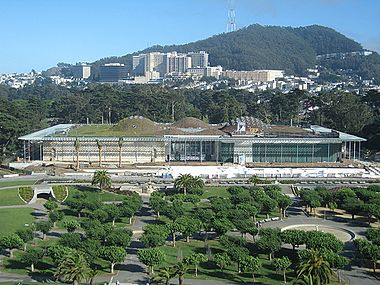
Many green roof projects have won awards for their design and benefits. Some notable examples include:
- The Green Roof Innovation Testing Laboratory in Toronto, Canada (2013 Award).
- The Brooklyn Botanic Garden Visitors Center in Brooklyn, USA (2013 Award).
- The California Academy of Sciences in San Francisco, USA (2009 Award).
- The Chicago City Hall Green Roof in Chicago, USA (2002 Award).
Images for kids
-
An intensive roof garden in New York City
See also
 In Spanish: Techo verde para niños
In Spanish: Techo verde para niños


